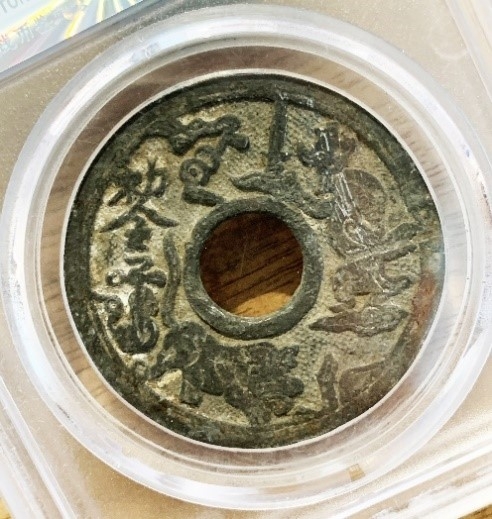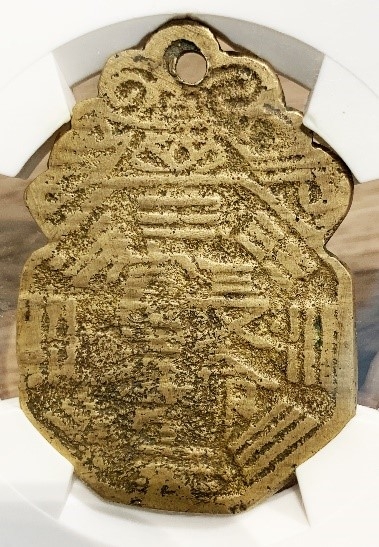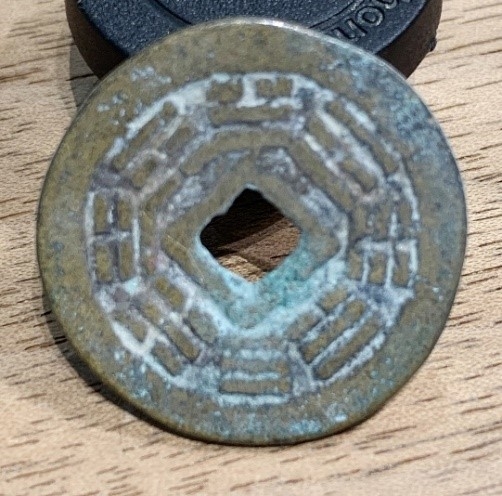 |
|
Trigrams Coin |
There are always friends or customers who are curious on the history and the background of Trigrams Coin. What exactly is a Trigrams Coin? It is neither money nor currency in circulation. It is actually a amulet coin which has Yin & Yang and The Eight Trigrams (BaGua) carved on it for different Feng Shui purposes, different materials (such as gold, silver, bronze, jade, wood, lead, bone, meteorite) are found in making the Trigrams Coin.
 |
 |
| Qing Dynasty Trigrams Coin |
Qing Dynasty Trigrams Coin with auspicious wordings |
To study Trigrams Coin, it is necessary to start with Ya-Sheng Wizardry. Ya-Sheng is a technique that people use to seek for good luck and fortune thus avoid evil and unfortunate, and Trigrams Coin is originated from or part of the Ya-Sheng Wizardry.
In Qing Dynasty, a book named Zibuyu that was written by the poet Yuan Mei (1716 - 1797 AD) has mentioned that Ya-Sheng has been used to help a woman who was requesting a baby. In Tang Dynasty, poet Du Fu (712 - 770 AD) talked about an ancient story that was happened in Qin Dynasty about employing Ya-Sheng to help on flood control.
Actually Ya-Sheng has been used as early as Han Dynasty, at that time Wang Mang (45BC- 23AD) has introduced Ya-Sheng in national military purpose.
 |
 |
| Qing Dynasty Bagua Trigrams Coin |
Qing Dynasty Trigrams Coin (with Taoist priest & Taichi Bagua) |
There were evidences of using Ya-Sheng Coin during the Han Dynasty as well, auspicious wordings or swastika symbol are engraved onto the coin with the purpose to pursue good fortune and avoid disaster. In fact, there was an ancient story about a monster called “Nian”, the monster appeared every year and brought sickness to children (another version said the monster ate human). In order to suppress the monster, adult would give Ya-Sheng Coin to children for protection every year.
 |
|
Han Dynasty Ya-Cheng Coin (with Swastika symbols) |
The central philosophy of Ya-Sheng Coin is to suppress or avoid evil and badness to achieve good fortune and blessing. It is not currency in circulation and solely used for amulet and talisman purpose. Some would use as burial artifact or tomb guardian, with the hope to continue enjoying the fortune in the afterlife.
There were quite a lot of recorded histories about using Ya-Sheng. In Northern Wei Dynasty, the Queen has used Ya-Sheng to cure his father’s (Wu Guozhen) disease (439 - 518AD). In Jin Dynasty, a person named Han You has used Ya-Sheng to cure the Magistrate’s (Deng Lin) wife and Lau XiJi’s daughter. Li BaoFu (733-794 AD) has also used Ya-Sheng for medical treatment at that period of time.
Besides, during the Northern Song Dynasty (1119-1125 AD), Song Huizong has sent Lin LinXu (Taoist priest) to use Ya-Sheng for flood control. In Dang Dynasty, the famous female Emperor Wu Zetian has employed Ya-sheng for fire control to her palace. It is confirmed that Ya-Sheng has been widely used in the ancient China no matter in the national or the common people level.
 |
 |
| Song Dynasty Ya-Cheng Coin |
Song Dynasty Ya-Cheng Coin (with tortoise & snake – represents longevity) |
In Song Dynasty, other than propitious animals (such as dragon, phoenix, crane, and fish), Taoism thinking was firstly introduced onto Ya-Sheng Coin. Taoist priest, Laozi, Big Dipper, Zhongkui(Chinese Ghost Buster), charm, etc were commonly found on Ya-Sheng coin at that period of time.
In Ming Dysnasty, Qing Dynasty, and Republic of China, the use of Ya-Sheng Coin has arrived its peak, the Eight Trigrams has always found on Ya-Sheng Coin for Feng Shui purposes, during this period of time no matter in beam raising ceremony, stove-opening ceremony, flood control, entrance guard, burial artifact, home or tomb or warehouse guardian, or different kinds of rituals, different kinds of Ya-Sheng and Trigrams coins were widely used. In the Forbidden City, the main buildings such as Taihe Palace - hall of supreme harmony, Baohe Palace - the Hall of Preserving Harmony, Hall of Martial Valor, and some other twenties places in the Forbidden City, Ya-Sheng coins were found to use as guardian amulet in the roof pillar.
 |
 |
| Qing Dynasty Longevity Trigrams Coin | Republic of China Auspicious Wording Trigrams Coin |
In addition, personal use has been extended to evil suppression, request for baby, health, career, wealth, status, academic achievement, divination, and etc... indeed, Ya-Sheng Coin has been widely used in personal perspectives.
 |
 |
|
The above two Trigrams Coins look alike, however; left one has the “Primordial Bagua” and right one has the “Manifested Bagua” |
|
The Eight Trigrams on Trigrams coin is originated from The Book of Changes, one of the oldest literature in China. It contains a set of symbols that represent the status of “yi”, and always present together with the Taichi Yin and Yang Diagram. Trigrams coin is actually amalgamation of the theory of “yi” and the Ya-Sheng Wizardry.
 |
 |
|
Republic of China Trigrams Coin (request for baby) |
Qing Dynasty Longevity Trigrams Coin |
Regarding actual usage, it is quite simple and direct among the people. People would just put whatever they want (in words) onto the Trigrams coin to pursue longevity, wealthy, safety, and protection; besides, diagrams, stories, or charms were also put onto the Trigrams coin to achieve this purpose.
 |
 |
|
Qing Dynasty Ya-Sheng Coin (with Charms) |
|
It is notable that different types of Eight Trigrams are found on the Trigrams coin; however some trigrams are wrongly drawn therefore it wouldn’t able to serve the original objective.
 |
 |
|
Republic of China Trigrams Coin, it is notable that although the front has engraved “Primordial Bagua”, the back has actually engraved “Manifested Bagua” with the details wrongly drawn |
|
Feng Shui Specialist yet has a very different handling and procedures when handling Trigrams coin. They would have to follow special doctrines and rituals in preparation and application, different Master would have its unique taboo, guideline, and restriction, some would employ cinnabar, others would use black lacquer. Though the methods or procedures are not the same, the intention was identical: to pursue good fortune and avoid evilness and badness.
 |
|
Qing Dynasty Trigrams Coin (with cinnabar) |
This article briefly discuss about Trigrams coin from the Feng Shui perspective, with the aim to arouse people’s attention and appreciation to this ancient (over a thousand year) culture.
Michael Ma
April 2019


